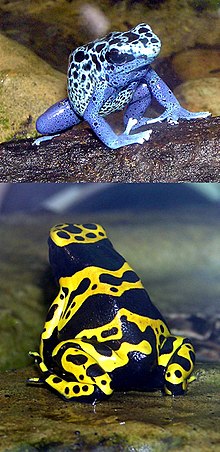Dendrobatidae
| Poison dart frogs (Dendrobatidae) | |
|---|---|
 |
|
| Dendrobates tinctorius "azureus" (top) and Dendrobates leucomelas (bottom). | |
| Scientific classification | |
| Kingdom: | Animalia |
| Phylum: | Chordata |
| Class: | Amphibia |
| Order: | Anura |
| Suborder: | Neobatrachia |
| Superfamily: | Dendrobatoidea |
| Family: |
Dendrobatidae Cope, 1865 |
| Subfamilies and genera | |
|
|
 |
|
| Distribution of Dendrobatidae (in black) | |
Poison dart frog (also known as dart-poison frog, poison frog or formerly known as poison arrow frog) is the common name of a group of frogs in the family Dendrobatidae which are native to tropical Central and South America. These species are diurnal and often have brightly colored bodies. This bright coloration is correlated with the toxicity of the species, making them aposematic. Some species of the Dendrobatidae family exhibit extremely bright coloration along with high toxicity, while others have cryptic coloration with minimal to no amount of observed toxicity. The species that have great toxicity, derive this from their diet of ants, mites and termites. Other species however, that exhibit cryptic coloration and low to no amounts of toxicity, eat a much larger variety of prey. Many species of this family are threatened due to human infrastructure encroaching the places they inhabit.
These amphibians are often called "dart frogs" due to the Amerindians' indigenous use of their to poison the tips of blowdarts. However, of over 170 species, only four have been documented as being used for this purpose (curare plants are more commonly used), all of which come from the genus Phyllobates, which is characterized by the relatively large size and high levels of toxicity of its members.
Most species of poison dart frogs are small, sometimes less than 1.5 cm (0.59 in) in adult length, although a few grow up to 6 cm (2.4 in) in length. They weigh 1 oz. on average. Most poison dart frogs are brightly colored, displaying aposematic patterns to warn potential predators. Their bright coloration is associated with their toxicity and levels of alkaloids. For example, frogs of the genus Dendrobates have high levels of alkaloids, whereas Colostethus species are cryptically colored and are not toxic.
Poison dart frogs are an example of an aposematic organism. Their bright coloration advertises unpalatability to potential predators. Aposematism is currently thought to have originated at least four times within the poison dart family according to phylogenetic trees, and dendrobatid frogs have since undergone dramatic divergences – both interspecific and intraspecific – in their aposematic coloration. This is surprising given the frequency-dependent nature of this type of defense mechanism.
...
Wikipedia
